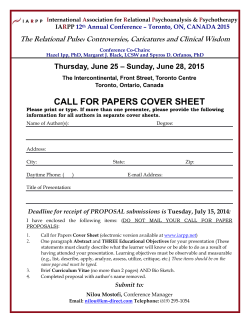
Chapter 15 Systemic theory and therapy
This handout is based on information in Finlay, L. (2015). Relational Integrative Psychotherapy: Process and Theory in Practice, Chichester, Sussex: Wiley. Chapter 15 Systemic theory and therapy Systems theory is inherently holistic, relational and integrative and are therefore of special significance for relational integrative therapists. Systemic approaches look at the way different systems interact and how they come together to make a whole greater than the sum of their parts (see figure 1). work & social relationships affect regulation system culture biochemical systems information processing system ecol ogy family system Figure 1 An individual’s intrapersonal-interpersonal systems The various intra- and inter-personal human systems identified above – both biological and social are of particular interest to us as psychotherapists. We recognise how a problem in one sub-system may create disrupt others. For example, problems with serotonin levels in a depressed person may lead to emotional instability, which disrupts that person’s ability to think/problem-solve and interact, which impacts on their wider world of family, work and social relationships. Like a stone thrown into a pond the ripples of disturbance (conflict, stress and confusion) impact on wider relationships, and vice versa. At the same time, stabilising community support systems can feedback positively into the system. Therapy engages directly with this wider world of interconnecting systems. Constructive intervention in any part of the whole system may interrupt a destructive spiral. For example, medication plus cognitive and gestalt approaches may be used to work with the intra-personal issues, while family therapy is used to address to some of the inter-personal dimensions. Importantly, systemic therapy works with problems arising not within the individual but rather within their wider life and social (cultural, political, economic) context. Applying a systems view in family therapy A systemic approach views the family as a whole, while also attending to dynamics between members. Minuchin (1974) used the term ‘family dance’ in an attempt to capture the way family members move in tandem with each other. Therapy interventions are designed to help clients become aware of their specific family dance and how they might change their steps. This handout is based on information in Finlay, L. (2015). Relational Integrative Psychotherapy: Process and Theory in Practice, Chichester, Sussex: Wiley. The primary focus of a family systems perspective is on function and the process of interactions, rather than content: in other words, how people interact rather than what they are saying. A family therapist might ask, “what unwritten ‘rules’ guide this family?” A loving family that does not tolerate the open expression of grief or vulnerability, for example, develops ways of avoiding and coping with these things. Family systems theory argues that that emotional relationships in families are often triangular: they tend to involve, say, two parents and a child; or one parent and two children etc. The coalitions/alliances of interest concern the way members interrelate to maintain the status quo. In a problematic marital triangle, for instance, a wife who is upset with her husband might turn to her child for comfort; the child may be pulled in to a drama triangle by becoming a ‘rescuer’. Or, a parent-child conflict may distract from marital tensions (‘detouring the conflict’). There are many versions of family therapy practised, e.g.: Structural family therapy ( Minuchin) is a short-term therapy that examines family relationships, behaviours, and patterns. Therapeutic goals include strengthening parental leadership, clarifying boundaries and developing coping skills. Role -plays are used to bring about changes in entrenched interaction patterns, such as overly confluent or disengaged interactional styles. Psychodynamic family therapy – This longer term therapy focuses on unconscious processes and projections. Couples/family member defences and anxieties are accessed in part through transference/counter-transference and are then interpreted to foster change while the therapist provides emotional holding/containing. Strategic family therapy - The aim of this brief, ‘solution-focused’ (Haley) approach is to identify symptoms (concrete problems) and find solutions by modifying dysfunctional communication patterns. The therapist teaches members how to listen, ask questions and respond non-defensively instead of reacting. Humanistic-experiential family therapy - Satir, a key name in this field, sees problems in families arising when emotions (anger and concern, for example) are not communicated in clear, direct ways, and when members’ self-esteem is not mutually enhanced through love and compassion. Intergenerational family therapy focuses on the generational legacy and its influence on both the individual and family. Current struggles may be rooted in ones handed down through the generations: for example, an adolescent’s rebellious behaviour may mask unresolved grief passed down generations. Reflections Beyond alerting us to the wider context, systems theory highlights how we are all caught up in a relational web, one spun with threads that become habitual interactional patterns that tie us in. Individuals are best understood “not in isolation, but in the context of their relations with others, past and present, internal and external, actual and fantasised” (Mitchell, 2000, p.107). Therapists are also a part of the web. Wouldn’t it be remiss if we weren’t aware of the impact of our therapeutic interventions on a client’s family, work relationships or broader social activities? Similarly, don’t we need to factor in the impact of our own family and work/social relationships? © Linda Finlay, 2015
© Copyright 2025













